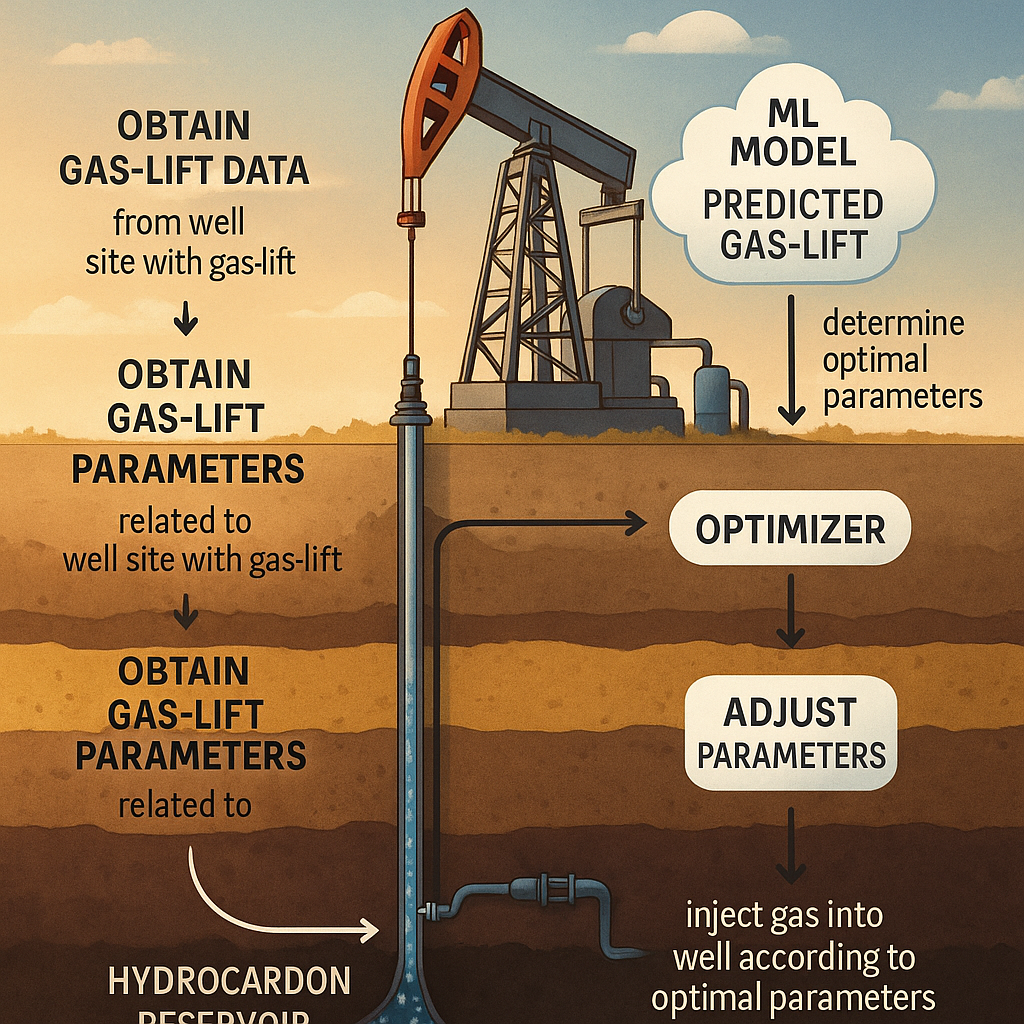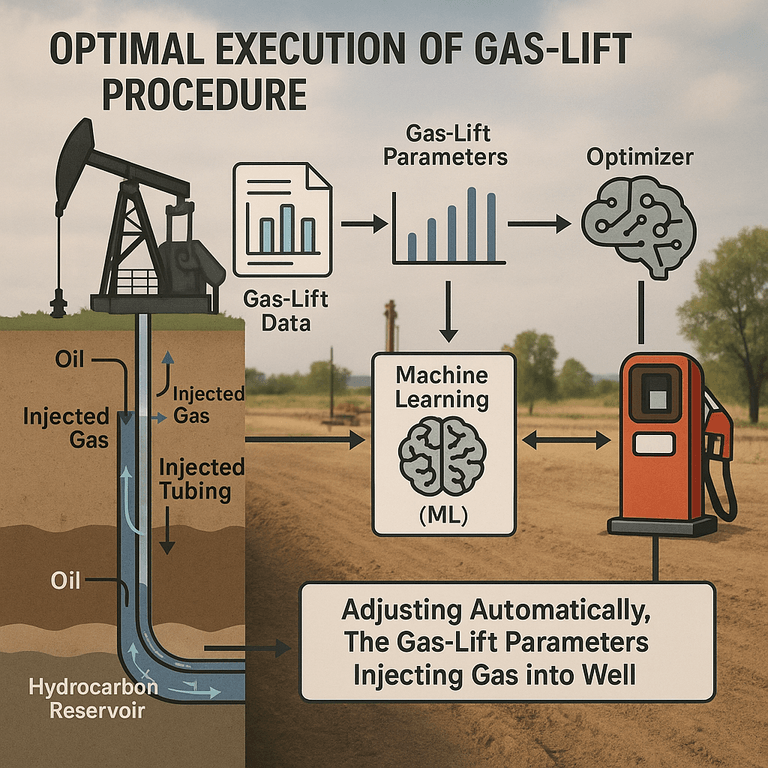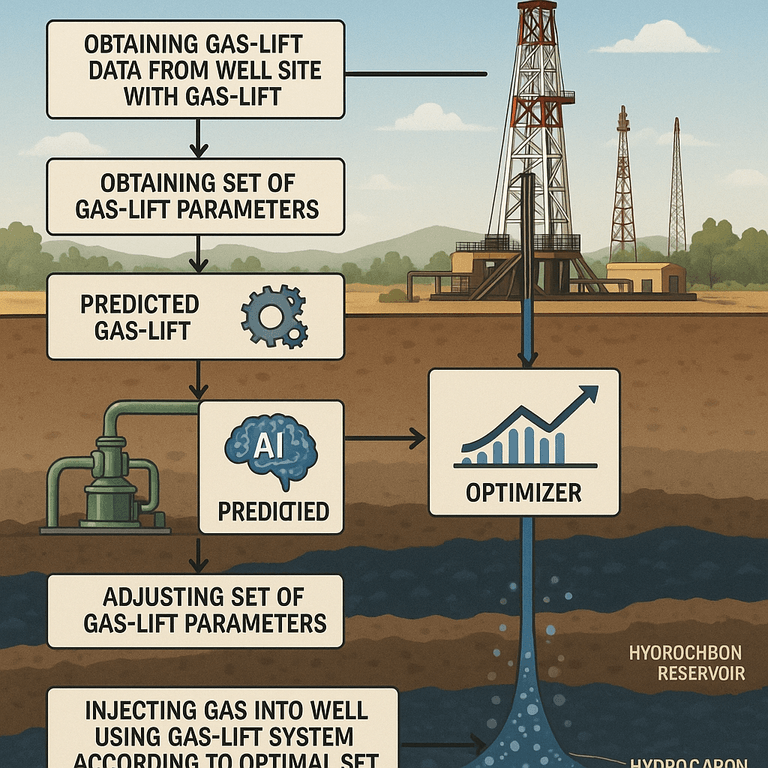Invented by Daanyal; Muhammad, Bayounis; Ryyan, Alquraini; Ali, Bukhamseen; Ibrahim, Alghamdi; Abdullah A, SAUDI ARABIAN OIL COMPANY
Gas-lift is a key method for getting oil and gas out of the ground when natural pressure is not strong enough. Today, new technology is making it much easier to run gas-lift systems in the best way. In this article, we will break down a new patent application that uses machine learning to help oil and gas companies get the most out of their wells. We will look at why this is important, what makes it different from old ways, and how the new invention works. Here is what you need to know.
Background and Market Context
When people drill wells for oil and gas, they hope the pressure underground will push the oil or gas up to the surface. But over time, this pressure drops, or sometimes it is never high enough to begin with. That is where gas-lift comes in. In a gas-lift system, workers inject gas down into the well. This mixes with the oil or fluid, making it lighter so it can flow up to the surface more easily.
Gas-lift is used all over the world, both on land and offshore. It is popular because it is cheaper and safer than some other methods. But it is not always simple. Each well is different. The right amount of gas, the best place to inject it, and the way the well is set up can all change over time. If you get it wrong, you waste gas, produce less oil, or even damage your equipment. That means you lose money.
Offshore wells, in particular, are expensive to operate. Getting gas and equipment to these remote places is hard. If the gas-lift system is not running just right, the costs add up fast. This is why companies look for better ways to run gas-lift systems without guesswork or trial and error. The oil and gas industry is always looking for smarter, safer, and more cost-effective solutions.
In the past, people had to rely on experience, rules of thumb, or slow manual testing to set up their gas-lift systems. That took time, and the results were not always great. Today, there is more interest in using sensors, computers, and smart software to help make these choices easier and faster. But even with lots of data, it can be hard to know what to do because the systems are complex and the conditions change often.
This is why the new patent application is so important. It offers a way to use machine learning, a type of artificial intelligence, to watch the well in real time and make smart choices about how to run the gas-lift system. The goal is to use the least gas possible, get the most oil, and avoid problems. For oil and gas companies, this means more profit and less risk.
Scientific Rationale and Prior Art
Gas-lift systems have been around for many years. The basic idea is simple: inject gas into the well to make the oil lighter, so it flows easier. But, as anyone in the industry knows, the details matter a lot. Each well has its own shape, depth, and mix of fluids. The reservoir under the ground also changes over time. Pressure, temperature, and even the type of oil can be different from one place to another. Because of this, gas-lift is not a “set it and forget it” technology.
Traditionally, engineers set up gas-lift systems using models and experience. They look at the well data—things like pressure at the top of the well, the amount of oil versus gas coming up, the depth of the well, and more. They also set parameters for the gas-lift system, like how much gas to inject and where to inject it. After making a change, they wait and see what happens. If the results are not good, they try again. This trial-and-error process can take a long time and does not always work well, especially if the well conditions change quickly.
To help, some companies started using more sensors and data logging. They put sensors down in the well and at the surface to measure things like pressure, temperature, and flow rates. This gives engineers more information, but it also creates a lot of data to sort through. Some tools use simple rules or formulas to help decide how to set the gas-lift parameters, but these rules are not always accurate for every well.
There have been efforts to use computer models to simulate well behavior. Some software like PROSPER can model how fluids move in the well, given certain gas-lift settings. But these models often need expert input and do not always account for real-world changes or surprises. They are good for planning, but not for real-time adjustments.
In the last few years, machine learning has become more common in the oil and gas industry. Machine learning models can look at lots of data and find patterns that would be hard for a human to spot. Some companies have used machine learning to predict when equipment might fail or to spot signs of trouble in a well. But using machine learning to run gas-lift systems in real time, choosing the best settings automatically, is still a new idea.
The main challenge is that wells are complicated. There are many things that can change—like the gas-to-oil ratio, the pressure in the reservoir, and the quality of the oil. Machine learning models need good data to learn from, and the right kind of model to make useful predictions. There is also the need for a way to turn the model’s predictions into real actions, like changing the gas injection rate or depth, without waiting for human approval every time.
The invention described in the patent application builds on all these earlier ideas but takes them a step further. It uses machine learning not just to look for problems, but to actually predict how the well will behave if the gas-lift settings are changed. It then uses an optimizer to pick the best settings, and it can send commands to the gas-lift system to make those changes automatically. This is a big shift from earlier methods, which relied on manual changes or simple rules.
By combining smart sensors, machine learning models trained on both real and simulated well data, and an optimizer that can try out different options, this invention aims to keep the well producing as much as possible, with as little waste as possible. It is designed to work in real time, so it can quickly adjust to changing conditions. This is a major step forward compared to older systems that needed lots of manual attention and could not keep up with fast changes in the well.
Invention Description and Key Innovations
The invention covered in this patent application is a smart system and method for running gas-lift operations in oil and gas wells. It uses a mix of real-time data, machine learning, and optimization to pick the best way to inject gas so that you get the most oil and use the least gas. Let’s look at how it works and what makes it special.
First, the system collects gas-lift data from the well. This includes things like the pressure at the top of the well, the ratio of gas to oil in the fluid coming up, temperatures, and more. Sensors both down in the well and at the surface gather this data and send it to a computer. The system also keeps track of the current settings for the gas-lift system, such as how much gas is being injected, at what rate, the depth where the gas is injected, and which path the gas takes into the well (like through coiled tubing or the annulus).
All of this data is sent to a machine learning (ML) model. This model is trained using both real-world well data and simulated data from well models. By learning from many examples, the ML model can predict what will happen if the gas-lift settings are changed. For example, it can estimate how much more oil might be produced if the gas is injected deeper, or if the rate is increased or decreased.
But the system does not just stop at making predictions. It uses an optimizer that works with the ML model to try out different combinations of gas-lift settings, looking for the best outcome. The optimizer can use different methods, like a genetic algorithm, to search for the settings that will give the best results. The goal can be different depending on what is important at the time—maybe you want to maximize oil production, or maybe you want to use the least gas, or maybe you want to find the best balance.
Once the optimizer finds the best set of gas-lift parameters, the system automatically updates the settings of the gas-lift equipment. This could mean changing the rate of gas injection, adjusting the depth where the gas is injected, or switching which conduit the gas travels through. The system then watches the results in real time, using data from the sensors, to make sure the changes worked as expected. If conditions change, the system can repeat the process, always looking for the best settings.
A key part of the invention is that it can work with different types of machine learning models, including neural networks and random forests. It can use both real-world data and simulated data for training, so it can learn even if there is not a lot of historical data for a new well. The system is also designed to be flexible, able to work with different types of wells and gas-lift systems, both onshore and offshore.
Another important point is that the system can be connected to field devices and control systems that actually operate the gas-lift equipment. This means it can send commands to change settings right away, without waiting for a person to look at the data and make decisions. Of course, there is still room for human oversight if needed, but the system is designed to handle most situations on its own.
The software can format its output so that it works with industry-standard tools, like Excel macros or popular oil well modeling software. This makes it easy for engineers to use the results in their existing workflows, or to review and validate what the system is doing.
The invention also includes strong feedback and validation. After making a change, it checks to see if the new settings actually improved production or reduced gas use. If not, it can try different settings, always learning and improving as it goes.
Some of the main innovations of this invention include:
– Using machine learning to predict well performance for different gas-lift settings, using both real and simulated data.
– Optimizing the gas-lift parameters in real time, based on current well conditions, not just set-and-forget rules.
– Automatically adjusting gas-lift settings using computer control, reducing the need for manual intervention.
– Validating the results in real time and making further adjustments as needed.
– Making the system flexible enough to work with many types of wells, sensors, and control systems.
– Providing outputs that can be used directly in industry-standard tools.
By bringing together all these parts, the invention gives oil and gas companies a powerful tool to get the most from their wells. It saves time, reduces waste, and helps avoid problems like over-injecting or under-injecting gas. It also makes it safer, since fewer people need to be on-site making manual adjustments, especially in difficult offshore environments.
In practice, this means better performance, lower costs, and higher profits for operators. It also means the industry can be more responsive to changing conditions, which is especially important as wells get older or as companies look to make the most of every drop of oil and gas.
Conclusion
The oil and gas industry is always looking for ways to be smarter, safer, and more efficient. This new invention uses machine learning and real-time optimization to take gas-lift operations to the next level. By using data from the well, making smart predictions, and automatically adjusting settings, the system helps companies get the most oil and gas with the least waste. It is a big step forward from old methods and is likely to become a key tool for operators everywhere. If you want your wells to run better and your costs to go down, this kind of technology is the future.
Click here https://ppubs.uspto.gov/pubwebapp/ and search 20250215772.




